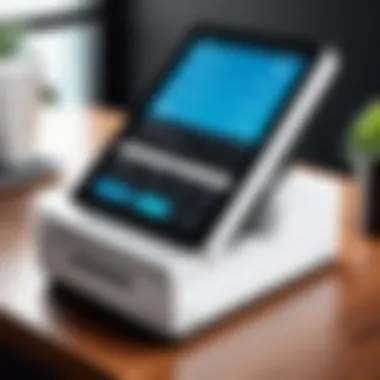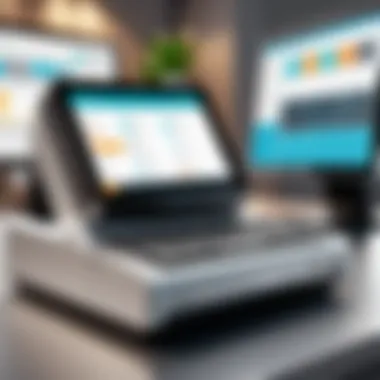Understanding Touch Point POS Systems in Business


Intro
Business today demands efficiency, accuracy, and the ability to adapt quickly. Touch Point POS (Point of Sale) systems serve a critical role in meeting these needs. They are more than just tools for processing sales; they encapsulate functionalities that streamline operations, enhance customer experiences, and support decision-making processes. By exploring this technology in detail, the article offers a foundation for industry-specific advisors and business owners to make informed choices about software selection.
The increasing reliance on digital solutions for transaction management is underpinning the relevance of POS systems. The landscape is continuously evolving with technology, and Touch Point POS stands at the forefront of this innovation, significantly impacting various business sectors.
Software Overview
Brief Description of Software
Touch Point POS systems are designed to facilitate sales transactions efficiently. They allow businesses to manage sales processes, inventory tracking, and customer data seamlessly. The software integrates with hardware components, creating a cohesive system that can handle everything from payment processing to reporting.
Key Features and Functionalities
Touch Point POS systems come with numerous features that streamline daily operations. Key functionalities include:
- Sales Management: Simplifies the sales process with quick transaction entries.
- Inventory Tracking: Monitors stock levels automatically, alerting users about restocking needs.
- Customer Relationship Management: Collects and analyzes customer data to improve service.
- Reporting and Analytics: Offers insights into sales trends and inventory performance.
- Multi-Channel Integration: Supports sales across different platforms, from online to physical stores.
The flexibility of these systems ensures they cater to various business models, from retail to hospitality.
Detailed Comparison
Comparison with Competitors
While Touch Point POS systems have strong offerings, it’s important to consider how they stack up against competitors like Square and Shopify POS. These alternatives also provide comprehensive solutions but may variate in pricing, user interface, and available features.
For instance, Square is known for its simple setup and competitive fees but may not offer as many advanced functionalities as Touch Point. Shopify POS offers seamless integration with e-commerce but can be more expensive for users focused solely on physical retail. Understanding these differences empowers users to choose the right solution for their specific needs.
Pricing Structure
The pricing of Touch Point POS systems varies based on features and business requirements. Generally, there are two models:
- Monthly Subscription Fees: Many systems charge a flat monthly fee that includes features and support.
- Transaction-Based Fees: Some models charge per transaction, which can be appealing for smaller businesses that have less volume.
Evaluation of these pricing models is crucial for businesses to balance cost and functionality.
"Selecting the right POS system is not merely about cost; it’s about aligning tech to enhance processes and satisfy customer needs."
Understanding the intricacies of Touch Point POS is pivotal for contemporary businesses aiming to elevate their operational capabilities and achieve long-term success.
Preamble to Touch Point POS
Touch Point POS systems play a crucial role in modern business operations. These systems streamline sales transactions, inventory management, and customer interactions. Understanding their functionality and significance is essential for decision-makers, IT professionals, and entrepreneurs looking to enhance operational efficiency and customer satisfaction.
In an increasingly digital landscape, businesses must adopt advanced technologies to remain competitive. Touch Point POS offers key advantages: they are intuitive, support quick transactions, and integrate seamlessly with other systems. These systems serve not just as cash registers but as vital tools for managing business processes.
Definition of Touch Point POS
Touch Point POS refers to a point-of-sale system that utilizes touch-based interfaces, usually through tablets, smartphones, or dedicated terminals. This technology allows users to conduct transactions with ease, offering a user-friendly experience that caters to both employees and customers.
The core functionality of Touch Point POS includes processing sales, managing customer data, and integrating with inventory and financial systems. This integration ensures that information flows efficiently across various business functions, enabling real-time updates and insights.
Historical Context and Evolution
The history of POS systems dates back to the late 19th century when mechanical cash registers first emerged. These devices were rudimentary and limited in functionality. However, with advancements in computer technology and the internet, the evolution towards Touch Point POS took shape.
In the 1980s and 1990s, electronic POS systems began to replace traditional cash registers. As businesses embraced technology, features expanded. Today, Touch Point POS systems leverage cloud computing and mobile technology, transforming how transactions are processed. This evolution reflects broader trends in digitization and reflects changing consumer expectations, emphasizing speed and convenience in service delivery.
"Touch Point POS systems are not just tools for transaction; they are essential for understanding customer behaviors and making informed business decisions."


Overall, the understanding of Touch Point POS systems is indispensable for businesses aiming to improve their operational tactics and customer engagement strategies.
Components of Touch Point POS Systems
The components of Touch Point POS systems are crucial in determining their effectiveness and usability. A well-structured POS system must integrate both hardware and software elements efficiently. Understanding these components helps businesses choose suitable solutions. Moreover, an awareness of different aspects can significantly improve operational workflows and customer service.
Hardware Requirements
Hardware forms the backbone of each POS system. This includes devices that facilitate transactions, interact with customers, and ensure the system runs effectively. Here, we explore the main hardware components crucial for an effective Touch Point POS system.
User Interface Devices
User interface devices are essential as they enable interaction between the user and the system. These can include touch screens, keyboards, and barcode scanners. The key characteristic of user interface devices is their ease of use. They are increasingly becoming popular in business settings. Touch screens, for example, offer a more intuitive experience compared to traditional keyboards.
One unique feature of user interface devices is their ability to streamline operations. Employees can quickly access necessary functions, leading to faster transaction times. However, there is a disadvantage; they require maintenance to ensure responsiveness, especially in high-traffic areas.
Payment Processing Hardware
Payment processing hardware such as card readers and terminals is another essential component. Its main role is to facilitate secure transactions. The key characteristic of payment processing hardware is its capacity to handle various payment methods, including credit, debit, and mobile payments. This versatility makes it a beneficial choice for many businesses.
A unique feature is the ability to integrate with mobile payment options, thus catering to consumer preferences. However, challenges such as cybersecurity threats can pose risks that businesses need to manage.
Networking Components
Networking components ensure that all devices within the POS system communicate effectively. Routers, switches, and network cables are essential here. The key characteristic of networking components is their role in maintaining reliable connections. A well-structured network can support multiple devices without downtime.
A unique feature of networking components is their ability to allow for cloud-based solutions. This can enable remote access and data management. Yet, disadvantages may arise in the form of vulnerability to network failures or security breaches, which require thorough safeguards.
Software Features
In addition to hardware, software features play a significant role in the functionality of POS systems. The right software aids in daily operations, from sales tracking to comprehensive inventory management, enhancing overall operational efficiency.
Inventory Management
Inventory management software is vital in maintaining stock levels and tracking products. Its key characteristic is real-time visibility into inventory status. This is beneficial as it helps in reducing stock discrepancies.
An important unique feature is the ability to automate reordering processes, ensuring that businesses do not run out of key products. However, without proper training, employees might struggle to utilize these functions effectively, which can lead to operational delays.
Sales Tracking
Sales tracking is essential for understanding consumer behavior. This software component aids businesses in analyzing sales data for trends. The key characteristic of sales tracking systems is their reporting functionality. This is beneficial because it offers insights that can guide marketing strategies.
One unique feature is their ability to forecast future sales trends based on historical data. Yet, the challenge lies in the potential for data overload, which can confuse rather than clarify if not handled properly.
Reporting and Analytics
Reporting and analytics software rounds off the functionality of POS systems. Its contribution is in transforming raw data into actionable insights. The key characteristic is its capacity for advanced reporting capabilities. This is beneficial because it helps in strategic decision-making based on thorough analysis.
One unique feature is the customization of reports according to specific business needs. Nonetheless, excessive reliance on data can lead to misinterpretation, particularly if stakeholders lack analytical skills.
Understanding these components allows businesses to effectively implement Touch Point POS solutions tailored to their needs.
Benefits of Implementing Touch Point POS
Touch Point POS systems offer significant advantages that can transform how businesses operate. As companies face challenges in streamlining processes, these systems present solutions that enhance operational performance, elevate customer satisfaction and drive informed decision-making. The adoption of Touch Point technology is not just about keeping up with industry trends; it is about reaping measurable benefits that can lead to a competitive edge.
Improved Operational Efficiency
Implementing a Touch Point POS system significantly enhances operational efficiency. The integration of various functions into a single platform minimizes redundancy and manual entries, which can lead to errors. This streamlined approach enables businesses to process transactions quickly. Staff can serve more customers in less time, increasing overall productivity.
- Inventory management becomes more precise. By automatically updating stock levels in real-time after each sale, businesses can reduce the risk of stockouts and overstock situations. This is especially crucial in environments with high product turnover.
- Sales reporting is much more efficient. Touch Point POS systems often come with advanced analytics, offering insights into sales trends, peak hours, and customer preferences. Such data helps managers allocate resources where needed and make timely adjustments to meet demand.
- Training employees becomes easier too. With a user-friendly interface, new staff can quickly learn to navigate the system. This efficiency in training saves time and reduces the learning curve for retail environments.


Enhanced Customer Experience
A well-implemented Touch Point POS system contributes to a better customer experience. When transactions are handled quickly and accurately, customers are likely to leave with a positive impression.
- Features such as customizable checkout processes allow businesses to tailor transactions to suit different customer needs, whether through gift wrapping options or loyalty program integrations. This personalization can foster loyalty.
- With mobile POS options, employees can check out customers anywhere in the store. This reduces wait times and enhances service delivery, which is vital for customer retention.
- Touch Point solutions often support multiple payment methods, including credit cards, mobile wallets, and even cryptocurrency. This flexibility meets customer preferences and encourages purchases.
Data-Driven Decision Making
The capability to access and analyze data from a Touch Point POS system supports data-driven decision-making that is crucial in today's business landscape. Organizations can leverage the information obtained from sales data to guide strategy effectively.
- Sales trends can be easily identified, helping businesses adjust their strategies and inventory accordingly. For instance, identifying which products are seasonal can allow for better stock management.
- Customer behaviors and preferences can be tracked, providing invaluable insights for targeted marketing campaigns. Knowing what customers buy can lead to more effective promotions that cater to their interests.
- Financial reports can be generated with ease, offering a clear picture of profitability, helping to plan future investments or adjustments in pricing strategies.
"Informed decisions reduce the risk of loss and enhance strategic growth over time."
The adoption of a Touch Point POS system is more than just a technological upgrade; it is an investment in improving business processes, enriching customer experiences, and fostering an environment where data drives the success of the organization.
Market Landscape of Touch Point POS Solutions
The market landscape for Touch Point POS solutions is a dynamic and rapidly evolving arena. Understanding this landscape is crucial for businesses looking to streamline their operations and enhance the customer experience. Various elements, such as key industry players, emerging trends, and technological advancements, shape this market. Analyzing these factors provides insights into the competitive environment and helps inform strategic decisions.
Key Players in the Industry
In the Touch Point POS solutions market, several key players dominate. These companies have set standards in technology and service, influencing the development of the whole sector. Notable among these players are:
- Square: Known for its user-friendly interface and robust features for small to medium-sized businesses.
- Shopify: Offers integrated POS and e-commerce solutions appealing to retail businesses.
- Lightspeed: Provides a strong inventory management system that supports various retail and hospitality sectors.
- Toast: Focuses primarily on restaurants with tailored features for food service.
These companies illustrate the diverse approaches to POS solutions, catering to different types of businesses and their unique requirements.
Emerging Trends and Innovations
The Touch Point POS market is not static. Emerging trends and innovations play a vital role in its evolution.
Cloud-Based Solutions
Cloud-based solutions represent a significant shift in the Touch Point POS landscape. This approach allows businesses to access their system from anywhere with an internet connection. A key characteristic of cloud-based solutions is scalability. Companies can easily adjust their service levels based on their needs. Businesses benefit from reduced hardware costs and geographical flexibility.
A unique feature of cloud-based systems is automatic updates. Users receive new software features and security upgrades without manual intervention. This offers an advantage as businesses can focus on daily operations instead of IT maintenance. However, reliance on the internet can present challenges, especially in areas with poor connectivity.
Mobile POS Systems
Mobile POS systems have gained considerable popularity due to their adaptability and convenience. These systems enable transactions using smartphones or tablets, allowing staff to assist customers anywhere within the store or restaurant. A distinctive characteristic of mobile POS is its portability. This empowers employees to engage with customers on the spot.
Mobile POS systems also come with unique features such as integrated inventory systems and customer management tools. The advantages include faster transaction processing and enhanced customer interaction. However, businesses must consider potential security issues, as mobile devices can be more vulnerable to breaches compared to traditional terminals.
As the Touch Point POS solutions market continues to evolve, understanding these emerging trends and key players becomes increasingly important for making informed business decisions.
The market landscape forms the foundation for evaluating and choosing the right POS system, ultimately impacting operational efficiency and overall customer satisfaction.
Challenges in Touch Point POS Implementation
Implementing Touch Point POS systems can provide significant operational benefits. However, businesses also face a variety of challenges during this process. Understanding these challenges is essential for effective planning and execution. Addressing these issues upfront can lead to a smoother transition and more efficient operations.
Integration with Existing Systems
Integrating a new Touch Point POS system with existing infrastructure is often one of the biggest hurdles. Many businesses might already have legacy systems in place, which can complicate integration. It is crucial to evaluate how well the new POS will work with current software and hardware.
Compatibility issues may arise that require additional adaptations or customizations, potentially increasing both time and costs. Moreover, ensuring seamless data flow between systems is paramount. Any discrepancies in data handling can lead to inventory mismanagement and poor customer service.
To mitigate these issues, a thorough analysis of existing systems is necessary. Companies should conduct pre-implementation assessments to identify potential integration points and gaps.


Considerations include:
- Understanding data transfer processes
- Assessing network infrastructure capacity
- Consulting with IT professionals for feasibility
As integration is a technical and strategic challenge, investing in robust support solutions become key. This ensures that the integration process is as smooth as possible, minimizing disruption to operations.
User Training and Adaptation
Another critical challenge is ensuring that staff is adequately trained on the new system. A Touch Point POS system can be sophisticated, and without proper training, user resistance may occur. Employees must feel comfortable and competent using the new technology to maximize its benefits.
Training programs should be designed to address different learning paces. It’s important to offer various methods of training, such as hands-on workshops, online courses, and one-on-one coaching. Employee feedback during training sessions can provide valuable insights into the difficulty level and areas needing more focus.
Key factors for effective training include:
- Setting clear learning objectives
- Creating user-friendly training materials
- Allowing for practice on the system
- Providing ongoing support and resources
It's equally important to foster an environment that encourages adaptation. Change management strategies can help teams embrace new technologies more readily. This way, barriers that hinder adaptation are reduced.
Selecting the Right Touch Point POS Solution
Choosing an appropriate Touch Point POS solution can significantly influence the operational success of a business. The right system not only streamlines processes but also enhances customer satisfaction. This section examines critical elements that decision-makers must consider when selecting a Touch Point POS solution. Understanding specific business needs, evaluating cost versus return on investment, and assessing vendor reputation are key considerations in this process.
Assessing Business Needs
Before selecting a Touch Point POS system, business leaders must evaluate existing operations and identify specific needs. This assessment involves understanding the business's workflow, customer interaction points, and what specific features of a POS system will be beneficial.
A few key strategies might include:
- Reviewing current processes: Analyze how transactions occur presently and identify bottlenecks. Understanding pain points can guide the selection of features like inventory management or payment processing.
- Engaging with staff: Gathering input from employees who use the system daily can provide insights into must-have features and limitations of current systems.
- Consideration of customer experience: Understanding how the POS impacts customer interactions is vital. A successful selection should prioritize systems that enhance the customer journey through ease of use and efficiency.
Evaluating Cost and ROI
Financial considerations are always paramount when choosing technology solutions. Business leaders must evaluate the cost of the POS system against its features and potential return on investment (ROI). Here are some factors to consider:
- Initial and ongoing costs: Look beyond purchase prices; consider installation, training, maintenance, and software updates. Initial expenses can be small, but ongoing costs can accumulate over time.
- Expected ROI: Calculate potential savings from improved operational efficiencies, such as reduced labor costs or increased sales through faster checkout speeds. A clear picture of ROI can justify the chosen investment.
- Scalability: Evaluate if the system can grow with your business. A solution that fits current needs but cannot adapt for future expansion may require replacement sooner than expected.
Vendor Reputation and Support
The reputation of the vendor plays a significant role in ensuring a successful implementation of a Touch Point POS system. A trustworthy vendor commits to ongoing support and service. Factors to consider include:
- Industry experience: Research how long the vendor has been in business and their success rate with other clients. Consider seeking testimonials or case studies from businesses similar to yours.
- Support services offered: Clarify what support the vendor promises after installation. Reliable vendors provide continuous support through user training, troubleshooting, and software updates.
- Community and resources: A well-established vendor often has a community of users and abundant resources for training and problem-solving. Engaging with this community can benefit long-term system use.
"Selecting the right touch point POS solution is not just a purchase; it’s an investment into the future of your business."
Ending
Touch Point POS systems are not merely tools; they represent a foundational element in modern business operations. As we conclude this exploration, it is essential to recognize the transformative potential these systems hold. They drive efficiency and offer profound insights, allowing businesses to adapt and thrive in a competitive landscape.
Future of Touch Point POS Systems
The future of Touch Point POS systems appears promising. Several trends indicate this trajectory. We see an increasing use of artificial intelligence and machine learning. These technologies enable advanced data analytics, improving decision-making processes for businesses. Moreover, integration with e-commerce platforms continues to rise. As businesses seek omnichannel solutions, a seamless connection between online and offline operations is imperative.
Another significant development is the rise of mobile payment options. With the growing adoption of digital wallets and contactless payments, businesses must adapt their systems to cater to this evolving consumer preference. The incorporation of enhanced security measures also cannot be overlooked, as protecting customer data remains a top priority.
In essence, the future is about greater integration and flexibility. Companies should focus on solutions that not only meet current demands but also anticipate future needs.
Final Thoughts for Advisors and Business Owners
For advisors and business owners, making informed decisions regarding Touch Point POS systems is critical. Understanding the unique needs of your business is the first step. Assessing operational workflows can reveal specific requirements for a POS solution. Once those needs are identified, evaluating potential vendors based on their reputation and support structures is vital.
Additionally, considering the total cost of ownership is essential. This includes purchase costs, ongoing support, and potential upgrades. A comprehensive ROI analysis will help ascertain the financial viability of investing in a new system.
In summary, the right Touch Point POS system can serve as a strategic advantage. By prioritizing the specific needs of their businesses and staying informed about evolving technologies, decision-makers can choose systems that foster growth and enhance customer satisfaction.
"In the age of digital transformation, a robust POS system can be a game-changer for businesses looking to streamline operations and enhance customer experiences."
Advisors and owners must stay ahead of trends and be ready to adapt, ensuring that their POS systems not only meet current requirements but also evolve with the changing landscape.





